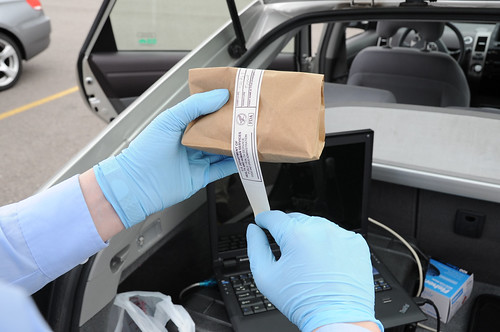FDA Uses Portable Rapid Testing Devices to Insure Patient Safety
The FDA has released photographs of a portable XRF analyzer designed to screen dietary supplements for toxic metals. The device is one of a new generation of portable screening tools, which will allow investigators to discover and seize adulterated drugs before they are available to consumers. The FDA’s new efforts rely on spectroscopic technologies that “analyze the dispersion of an object’s light determine the object’s chemical or molecular composition.”

FDA Portable Screening Devices
courtesy of the FDA via Flickr.
The FDA has released photographs of a portable XRF
analyzer designed to screen dietary supplements for toxic metals. The device is
one of a new generation of portable screening tools, which will allow
investigators to discover and seize adulterated drugs before they are available
to consumers. The FDA’s new efforts rely on spectroscopic technologies that
“analyze the dispersion of an object’s light determine the object’s chemical or
molecular composition.”
FDA Commissioner Margaret Hamburg spoke about FDA’s new
detection technologies in her keynote for Partnership for Safe
Medicine’s Interchange in 2012. She characterized Counterfeit Detection Device
3 (“CD3”), which was already in use in 50 FDA field laboratories,
as low cost and effective, offering real time comparisons between the drugs
being tested and authentic medicines.
The FDA has a team of more than 2,000 scientifically trained specialists who conduct inspections and analyze product samples, in the monitoring of regulated products coming into the U.S. Benjamin Westenberger, deputy director of the agency’s Division of Pharmaceutical Analysis, says that the volume of medicines imported in the U.S. has more than doubled in the past decade, challenging the capacity of the import-testing process used in most inspections. These portable devices could significantly identify counterfeiting of medicines and dietary supplements.
A team at King’s College London is developing a similar
device to detect substandard drugs. They released a study last month claiming that they
were able to use spectroscopic analysis to detect substandard antimalarial
medicines without even removing the drugs from their packaging.
Such devices offer a portable and fast way to screen for
counterfeit drugs. An FDA article about these new technologies
notes that current procedure requires investigators to collect 5 or 6 samples
of questionable medicines and deliver them to a lab for what can be a week long
delay before receiving a verdict about the quality and safety of a product.
Although suspicious results will require additional lab work, the XRF analyzer
offers an initial positive or negative screen of a medicine in as little as 30 seconds.